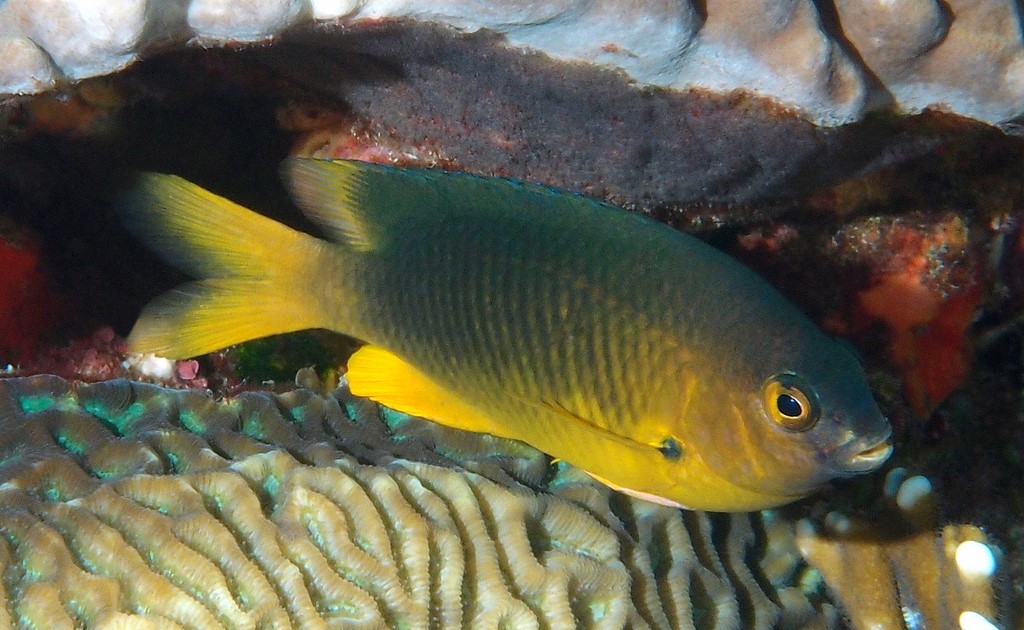PLECTROGLYPHIDODON GASCOYNEI - (WHITLEY, 1964)
Actinopterygii (Gigaclass) > Actinopteri (Class) > Teleostei (Subclass) > Blenniiformes (Order) > Pomacentridae (Family) > Microspathodontinae (Subfamily) > Plectroglyphidodon (Genus)
Coral Sea gregory, Gold-belly gregory, 珊瑚海真雀鯛, 蓋氏眶鋸雀鯛,
Synonymes
Pseudopomacentrus gascoynei (Whitley, 1964)
Stegastes gascoynei (Whitley, 1964)
-------------------------
Description
Dorsal spines (total): 14; Dorsal soft rays (total): 14-16; Anal spines: 2; Anal soft rays: 13-14. Max. length: 15.0 cm TL. Depth range: 1 - 30 m.
Color
Body and head color primarily brown, yellow-orange on ventral portion. A blue streak runs from the snout to the suborbital. Blue or purplish spots are on opercular series. Each scale with dark brown streak near its margin, appearing as series of narrow transverse bands. The dorsal is fin brown, posteriormost is somewhat translucent. The caudal fin is tan to brown, outermost part translucent to yellowish. The anal and pelvic fins yellow to orange. The pectorals are transparent with suffusion of yellow with a small dark spot superiorly at its base.
Etymology
Plectroglyphidodon: from Greek, plektron = anything to strike with, spur + from Greek, glyphis = carved + from Greek, odous = teeth.
gascoynei: named after H.M.A.S. Gascoyne, from aboard which the new species was collected during a survey of the islands in the Coral Sea. Two ships of the Royal Australian Navy have been named HMAS Gascoyne, after the Gascoyne River, the longest river in Western Australia. HMAS Gascoyne (K354/F354/A276) was a River-class frigate that served in the Royal Australian Navy (RAN). Laid down in 1942 and commissioned in 1943, the frigate served during World War II, before being placed in reserve in 1946. Reactivated in 1959, Gascoyne was reclassified as a survey and research ship, a role she fulfilled until she was decommissioned again in 1966, and sold for scrap in 1972.
Original description: Pseudopomacentrus gascoynei Whitley, 1964 - Type locality: Kenn Reef, Coral Sea.
Distribution
Southwestern Pacific: Coral Sea east to New Caledonia and Kermadec Islands, south to northern New Zealand.
Biology
Adults inhabit coral and rocky reefs. Oviparous, distinct pairing during breeding. Eggs are demersal and adhere to the substrate. Males guard and aerate the eggs.
Coral Sea gregory, Gold-belly gregory, 珊瑚海真雀鯛, 蓋氏眶鋸雀鯛,
Synonymes
Pseudopomacentrus gascoynei (Whitley, 1964)
Stegastes gascoynei (Whitley, 1964)
-------------------------
Description
Dorsal spines (total): 14; Dorsal soft rays (total): 14-16; Anal spines: 2; Anal soft rays: 13-14. Max. length: 15.0 cm TL. Depth range: 1 - 30 m.
Color
Body and head color primarily brown, yellow-orange on ventral portion. A blue streak runs from the snout to the suborbital. Blue or purplish spots are on opercular series. Each scale with dark brown streak near its margin, appearing as series of narrow transverse bands. The dorsal is fin brown, posteriormost is somewhat translucent. The caudal fin is tan to brown, outermost part translucent to yellowish. The anal and pelvic fins yellow to orange. The pectorals are transparent with suffusion of yellow with a small dark spot superiorly at its base.
Etymology
Plectroglyphidodon: from Greek, plektron = anything to strike with, spur + from Greek, glyphis = carved + from Greek, odous = teeth.
gascoynei: named after H.M.A.S. Gascoyne, from aboard which the new species was collected during a survey of the islands in the Coral Sea. Two ships of the Royal Australian Navy have been named HMAS Gascoyne, after the Gascoyne River, the longest river in Western Australia. HMAS Gascoyne (K354/F354/A276) was a River-class frigate that served in the Royal Australian Navy (RAN). Laid down in 1942 and commissioned in 1943, the frigate served during World War II, before being placed in reserve in 1946. Reactivated in 1959, Gascoyne was reclassified as a survey and research ship, a role she fulfilled until she was decommissioned again in 1966, and sold for scrap in 1972.
Original description: Pseudopomacentrus gascoynei Whitley, 1964 - Type locality: Kenn Reef, Coral Sea.
Distribution
Southwestern Pacific: Coral Sea east to New Caledonia and Kermadec Islands, south to northern New Zealand.
Biology
Adults inhabit coral and rocky reefs. Oviparous, distinct pairing during breeding. Eggs are demersal and adhere to the substrate. Males guard and aerate the eggs.
